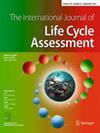Life cycle assessment of a marine biorefinery producing protein, bioactives and polymeric packaging material
IF 5.4
3区 环境科学与生态学
Q2 ENGINEERING, ENVIRONMENTAL
引用次数: 0
Abstract
Abstract Purpose Algal research has been dominated by the use of marine biomass (mainly microalgae) as feedstock in the production of second-generation biofuels, albeit with limited economic success. A promising alternative strategy is the valorisation of seaweed (macroalgae), with the cascaded extraction of its high-value components, as well as lower-value components further downstream, under the ‘biorefinery concept’. The goal of this study was to assess the environmental performance of one such marine biorefinery situated in the UK. Methods Attributional life cycle assessment (LCA) was conducted on a hypothetical marine biorefinery coproducing fucoidan, laminarin, protein and alginate/cellulose packaging material (target product), from cultivated Saccharina latissima . The functional unit was the production of 1 kg of packaging material. A total of 6 scenarios were modelled, varying in coproduct management methodology (system expansion, mass allocation or economic allocation) and applied energy mix (standard or green energy). Sensitivity analysis was also conducted, evaluating the systems response to changes in allocation methodology; product market value; biomass composition and transport mode and distance. LCA calculations were performed using OpenLCA (version 1.10.3) software, with background processes modelled using the imported Ecoinvent 3.6 database. Environmental impacts were quantified under ReCiPe methodology at the midpoint level, from the ‘Heirarchist’ (H) perspective. Results and discussion The overall global warming impacts ranged from 1.2 to 4.52 kg CO 2 eq/kg biopolymer, with the application of economic allocation; 3.58 to 7.06 kg CO 2 eq/kg with mass allocation and 14.19 to 41.52 kg CO 2 eq/kg with system expansion — the lower limit representing the instance where green electricity is used and the upper where standard electricity is employed. While implementing the green energy mix resulted in a 67% reduction in global warming impacts, it also incurred a 2–9 fold increase in overall impacts in the categories of terrestrial acidification, human non-carcinogenic toxicity, land-use and terrestrial ecotoxicity. Economic allocation resulted in burden shifting most favourable to the packaging material pathway. Conclusions This study demonstrates that the road to environmental optimisation in marine biorefineries is fraught with trade-offs. From the perspective of LCA — and by extension, the eco-design process that LCA is used to inform — when evaluating such product systems, it serves to strike a balance between performance across a broad spectrum of environmental impact categories, along with having consideration for the nature of energy systems incorporated and LCA methodological elements. Graphical Abstract生产蛋白质、生物活性物质和聚合包装材料的海洋生物精炼厂的生命周期评估
藻类研究一直以利用海洋生物质(主要是微藻)作为第二代生物燃料生产的原料为主导,尽管经济上的成功有限。一个有希望的替代策略是海藻(大型藻类)的增值,在“生物炼制概念”下,通过级联提取其高价值成分,以及下游的低价值成分。本研究的目的是评估位于英国的一个这样的海洋生物精炼厂的环境性能。方法对一个假想的海洋生物精炼厂进行归因生命周期评估(LCA),该精炼厂以栽培的糖精为原料,生产褐藻聚糖、层粘胶蛋白、蛋白质和海藻酸盐/纤维素包装材料(目标产品)。功能单位为生产1公斤包装材料。总共模拟了6种情景,在副产品管理方法(系统扩展、大规模分配或经济分配)和应用的能源组合(标准能源或绿色能源)方面有所不同。还进行了敏感性分析,评估系统对分配方法变化的反应;产品市场价值;生物质组成、运输方式和距离。LCA计算使用OpenLCA (version 1.10.3)软件进行,后台进程使用导入的Ecoinvent 3.6数据库建模。从“世袭主义”(H)的角度出发,采用ReCiPe方法在中点水平对环境影响进行了量化。结果与讨论在经济配置的应用下,全球变暖的总体影响范围为1.2 ~ 4.52 kg co2当量/kg生物聚合物;3.58至7.06千克二氧化碳当量/千克(质量分配)和14.19至41.52千克二氧化碳当量/千克(系统扩展)——下限代表使用绿色电力的情况,上限代表使用标准电力的情况。虽然实施绿色能源组合使全球变暖影响减少了67%,但它也导致陆地酸化、人类非致癌毒性、土地利用和陆地生态毒性等类别的总体影响增加了2-9倍。经济分配导致负担转移最有利于包装材料途径。本研究表明,海洋生物精炼厂的环境优化之路充满了权衡。从LCA的角度来看,通过扩展,LCA用于通知的生态设计过程,在评估此类产品系统时,它有助于在广泛的环境影响类别之间的性能之间取得平衡,同时考虑到所纳入的能源系统的性质和LCA方法元素。图形抽象
本文章由计算机程序翻译,如有差异,请以英文原文为准。
求助全文
约1分钟内获得全文
求助全文
来源期刊
CiteScore
10.60
自引率
10.40%
发文量
100
审稿时长
8-16 weeks
期刊介绍:
The International Journal of Life Cycle Assessment (Int J Life Cycle Assess) is the first journal devoted entirely to Life Cycle Assessment and closely related methods. LCA has become a recognized instrument to assess the ecological burdens and impacts throughout the consecutive and interlinked stages of a product system, from raw material acquisition or generation from natural resources, through production and use to final disposal. The Int J Life Cycle Assess is a forum for scientists developing LCA and LCM (Life Cycle Management); LCA and LCM practitioners; managers concerned with environmental aspects of products; governmental environmental agencies responsible for product quality; scientific and industrial societies involved in LCA development, and ecological institutions and bodies.

 求助内容:
求助内容: 应助结果提醒方式:
应助结果提醒方式:


